
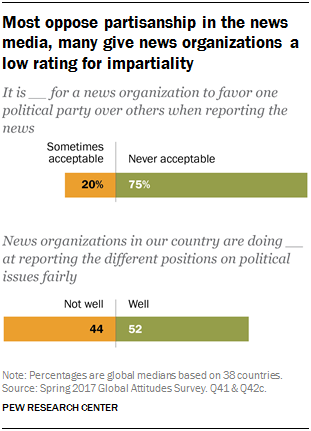
Publics around the world overwhelmingly agree that the news media should be unbiased in their coverage of political issues, according to a new Pew Research Center survey of 38 countries. Yet, when asked how their news media are doing on reporting different political issues fairly, people are far more mixed in their sentiments, with many saying their media do not deliver. And, in many countries, there are sharp political differences in views of the media – with the largest gap among Americans.
To build off Pew Research Center’s earlier findings about U.S. news media habits and attitudes, this new cross-national survey begins to study these dynamics globally. The survey finds that a median of 75% across 38 countries say it is never acceptable for a news organization to favor one political party over others when reporting the news. Just 20% say this is sometimes okay. People in Europe show the greatest opposition to political bias in their news, including 89% in Spain and 88% in Greece who think this is unacceptable. In the United States, 78% say the news media should never favor one political party over another. In only five countries do at least three-in-ten believe it is okay to favor one side.
Throughout this report, median percentages are used to help readers see overall patterns. The median is the middle number in a list of figures sorted in ascending or descending order. In a survey of 38 countries, the median result is the average of the 19th and 20th figures on a list of country-level findings ranked in order. In addition to medians of respondents across the survey’s 38 countries, this report sometimes refers to the median among a specific subset of respondents and/or countries by region or economic grouping. For example, we can look at a median across the seven Asian-Pacific countries, where the median is the fourth figure when the countries are listed from highest to lowest. We can also calculate the medians across 10 European nations, five Middle East-North African nations, six sub-Saharan African nations and seven Latin American nations.
While publics around the globe place a premium on politically unbiased news media, this is precisely the performance area, among four asked about, where publics are least likely to say their news media are doing well. A median of only 52% across the 38 nations polled say the news media in their country do a good job of reporting on political issues fairly, while 44% say they do not. And although majorities of the public in 18 countries say their news media are performing well in this area, attitudes are more negative in the remaining 20 nations surveyed. The most critical are Spain, Greece, South Korea, Lebanon and Chile, where at least six-in-ten say their news media do not do well on reporting the news fairly.
News media receive considerably higher marks in other performance areas. Broad majorities say their news media do a good job of covering the most important stories (median of 73%), reporting the news accurately (62%), and reporting news about government leaders and officials (59%). People in sub-Saharan Africa and the Asia-Pacific are more satisfied with their news media, while Latin Americans are the most critical. The U.S. public tends to fall roughly in the middle across the different performance areas asked about.
Within countries, political identification tends to be the strongest divider of media attitudes, more so than education, age or gender.
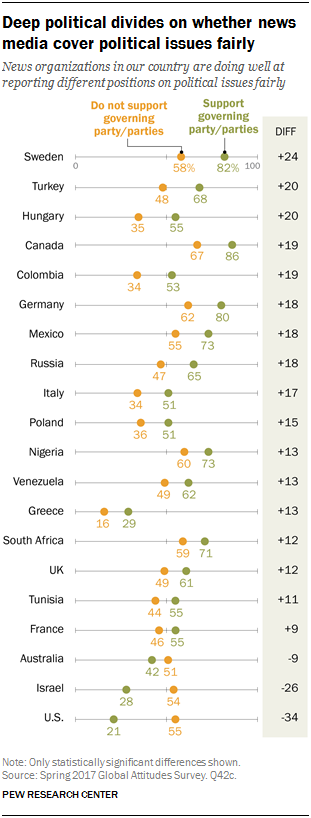
Political party systems vary considerably across countries, but one consistent measure for comparing political divides is support for the governing party or parties. Individuals who identify with the governing party or parties are categorized as supporters, everyone else as nonsupporters. In the U.S., this means that people who identify with the Republican Party, which currently controls all branches of the federal government, are considered governing party supporters. People who identify with the Democratic Party, say they are independent, identify with some other party or do not identify with any political party are categorized as nonsupporters. (For more details on the categorization, please see Appendix B.)
Using this approach, large gaps in ratings of the media emerge between governing party supporters and nonsupporters. On the question of whether their news media cover political issues fairly, for example, partisan differences appear in 20 of the 38 countries surveyed. In five countries, the gap is at least 20 percentage points, with the largest by far in the U.S. at 34 percentage points. The next highest partisan gap is in Israel, with a 26-point difference.
The U.S. is also one of only a few countries where governing party supporters are less satisfied with their news media than are nonsupporters. In most countries, people who support the political party currently in power are more satisfied with the performance of their news media than those who do not support the governing party. For example, in Sweden, the Social Democratic Party and the Green Party are the two parties that currently form the governing coalition in the country. About eight-in-ten Swedes (82%) who identify with these two parties say their news media do a good job of covering political issues fairly. Just 58% of Swedes who do not identify with these two parties agree.
The partisan gaps found in the survey indicate that, rather than being consistently tied to a particular ideological position, satisfaction with the news media across the globe is more closely related to support for the party in power – whether that party is left or right. Public satisfaction with the news media also links closely to trust in one’s national government and a sense that the economy is doing well, which reinforces the point that, for most countries surveyed here, satisfaction with the media aligns with satisfaction on other country conditions rather than along a left-right spectrum.
These are among the major findings of a Pew Research Center survey conducted among 41,953 respondents in 38 countries from Feb. 16 to May 8, 2017. In addition to the topics discussed above, the study also focuses on individuals’ use of the internet and social media to get news, as well as the types of news people follow.
Online news is making inroads in many countries around the world
Digital technology is influencing news habits across the globe, though its use is still far from universal. Overall, a median of 42% among the 38 countries surveyed say they get news on the internet at least once a day. In 14 countries, half or more adults get news online daily.
In general, internet access has been shown to be higher in wealthier countries, and this plays out to a greater likelihood of using the internet for news as well. For example, 61% in Australia – which had a 2015 gross domestic product (GDP) per capita of $46,271 – get news at least once a day through the internet. Just 20% in Senegal, with a GDP per capita of $2,421, do the same.
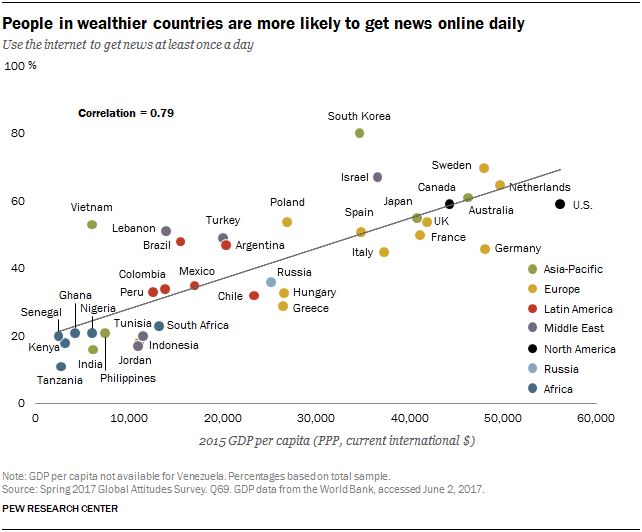
The survey also asked a separate question about how often people get news specifically on social media sites. Unlike getting news on the internet generally, the percentage that gets news on social media is not strongly related to country wealth. In fact, the median percentages of people who get news at least once a day through social media are about the same in emerging and developing economies as in advanced ones (33% and 36%, respectively). Overall, a global median of 35% get news daily through social media, with the highest levels in South Korea (57%), Lebanon (52%) and Argentina (51%).
For this report, we grouped countries into three economic categories: “advanced,” “emerging” and “developing.” In creating our economic classification of the countries in this report, we relied on multiple sources and criteria. Specifically, we were guided by: World Bank income classifications; classifications of emerging markets by other multinational organizations, such as the International Monetary Fund; per capita gross domestic product (GDP); total size of the country’s economy, as measured by GDP; and average GDP growth between 2010 and 2015. For more information, see Appendix C.
Public is highly engaged with news, but more so with news that’s close to home
Overall interest in the news has implications for how news media landscapes develop alongside technological change. Large majorities around the world say they follow national and local news closely (global medians of 86% and 78% respectively). In all 38 countries, more than two-thirds say this of news about their own country. The same is true of news about their city or town in 32 countries.
People are much less interested in news about other countries (global median of 57%). In only six countries do more than two-thirds say they pay close attention to news about the rest of the world. People outside of the U.S. express a similarly low level of interest in news specifically about the U.S. (48%).
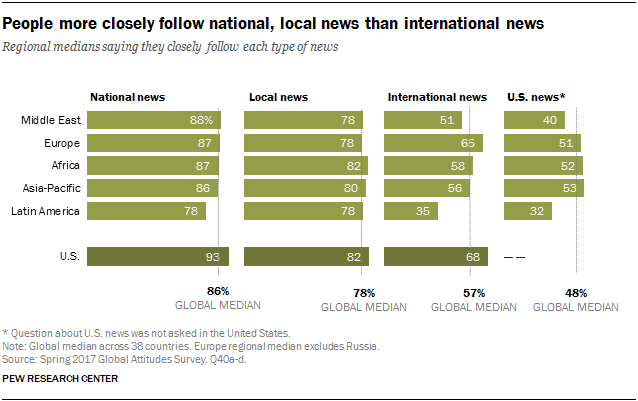
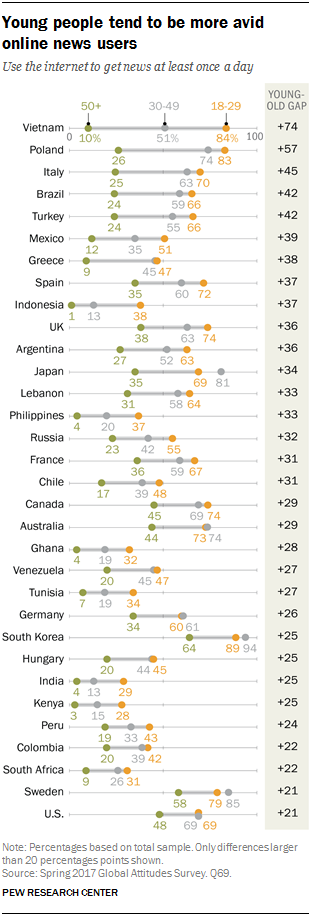
Young more likely to get news online; older people more likely to follow the news overall
Across all 38 countries, young people – those ages 18 to 29 – are more likely to get news online than adults 50 and older. In 11 countries, the age gap is 35 percentage points or greater.
At the same time, older people tend to be more interested in the various types of news asked about than the younger generation. The biggest gaps are in news about one’s own city or town. In 20 countries, people ages 50 and older are significantly more likely than people younger than 30 to closely follow local news. The age gap is at least 15 percentage points in 11 of the countries. Only in the Philippines and Brazil is the pattern reversed; there, young people are more likely to follow local news.
For international news, age is less of a factor. In general, men and those with more education are more likely to follow international news.




